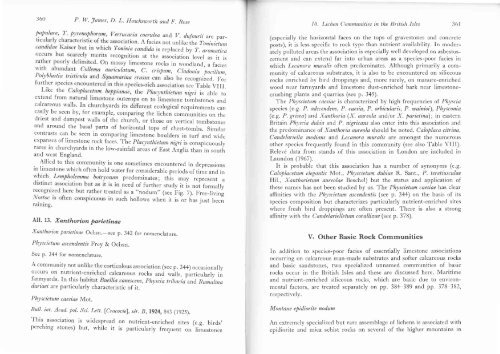Lichen communities in the British Isles: A preliminary conspectus
Lichen communities in the British Isles: A preliminary conspectus
Lichen communities in the British Isles: A preliminary conspectus
You also want an ePaper? Increase the reach of your titles
YUMPU automatically turns print PDFs into web optimized ePapers that Google loves.
360 P. W. James, D. L. Haz.okszoorth and tr,. Rose 10. <strong>Lichen</strong> Commwities <strong>in</strong> <strong>the</strong> <strong>British</strong> <strong>Isles</strong><br />
coerulea ar'd V. dufourii are par_<br />
. A facies not unlike <strong>the</strong> Ton<strong>in</strong>i)ttnn<br />
tia candida is replacecl by T. aromatica<br />
s recognition at <strong>the</strong> association level as it is<br />
n mossy limestone rocks <strong>in</strong> woodland, a facies<br />
ouriculatum' C' crispum,<br />
polyblastia<br />
Cladonia 1>ocillum,<br />
t<br />
ruriher speci ::'""i-Xf,'J^"r1",:<br />
I-ike <strong>the</strong><br />
ntgri is able to<br />
extend from<br />
calcareous walls. In churchyards its difierent ecological ,.Tfrr|.l".T::ll<br />
e.asily be seen by, for example, compar<strong>in</strong>g <strong>the</strong> lichen <strong>communities</strong> on trre<br />
driest and dampest walls of <strong>the</strong> church, or those on verticar tombstones<br />
and around <strong>the</strong> basal parts of horizontal tops of chest-tombs. similar<br />
contrasts can be seen <strong>in</strong> compar<strong>in</strong>g limestone boulders <strong>in</strong> turf and u,iclc<br />
expanscs of limestone rock faces. The placynthietum nigri is conspicuouslv<br />
rarer <strong>in</strong> churchyards <strong>in</strong> <strong>the</strong> low-ra<strong>in</strong>fall areas of East Angria th""'i;:;;;;<br />
and west England.<br />
Allied to this community is one sometimes encountered <strong>in</strong> depressions<br />
<strong>in</strong> limestone which often hold water fc r considerable periods of ii-. ancr <strong>in</strong><br />
osum predom<strong>in</strong>ates; this may represent a<br />
is <strong>in</strong> need of fur<strong>the</strong>r study it is noi formally<br />
reated as a "nodum" (see Fig. 7). Free_liv<strong>in</strong>g<br />
<strong>in</strong> such hollows when it is or has just becn<br />
All. 13. Xonthorion pariet<strong>in</strong>ae<br />
Xanthorion pariet<strong>in</strong>ae Ochsn.-see p. 342 for nomenclature.<br />
Physciehtm ascendentis Frey & Ochsn.<br />
See p, 344 for nomenclature.<br />
A community not s association (sec p. 344) occasionally<br />
occurs on nutrie us rocks urrd *ullr, particularly <strong>in</strong><br />
farmyards. In thi scens, physcia tribaclia and, Ramal<strong>in</strong>a<br />
duriaei are particularly characteristic of it.<br />
Physcietum caesiae Mot.<br />
Bull. <strong>in</strong>t. Acad. pol. Sci. Lett. lCracoaie], ser. B,1924, g43 (1925).<br />
This association is widespread on nutrient_enriched sites<br />
perch<strong>in</strong>g stones) but, while it is particularly frequent on<br />
(e.g. birds'<br />
limestones<br />
(espccially <strong>the</strong> Jrorizontal faces on <strong>the</strong> tops of gravestoncs and concrete<br />
posts), it is lcss specific to rock type than nutrient availability. In moderately<br />
pollutecl areas <strong>the</strong> association is especially well developed





